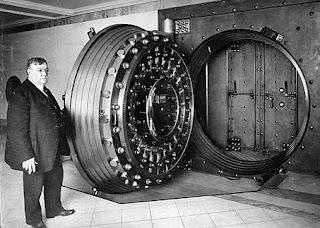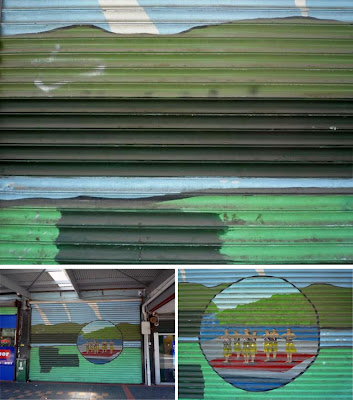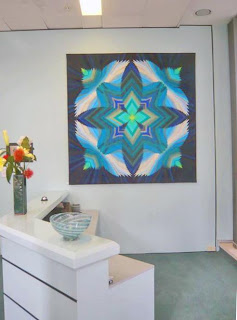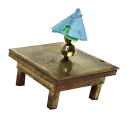Click on images to enlarge
Saturday, April 30, 2011
David in Adland: Volume 1
Click on images to enlarge
Posted by
jim and Mary
at
6:59 AM
![]()
![]()
Labels: art in adland
Friday, April 29, 2011
One of the world’s greatest art works to see before you die
Thursday, April 28, 2011
Whatamibidforthisbeautifulcolinmcahonlandscapeonboard?
Wednesday, April 27, 2011
One day in the marketing Department
Posted by
jim and Mary
at
6:59 AM
![]()
![]()
Labels: media, one day in, PR
Tuesday, April 26, 2011
By the numbers
2.5 the average number of dollars that American art critic Robert Storr is paid per word
7 the number of years jail time a 62-year-old art dealer from Mainz was given for forging thousands of art works including 13 Giacometti sculpture
Saturday, April 23, 2011
Thursday, April 21, 2011
It all ads up
Posted by
jim and Mary
at
11:55 AM
![]()
![]()
Labels: advertising
Counter culture
Posted by
jim and Mary
at
6:59 AM
![]()
![]()
Labels: art museum, audience, Te papa
Wednesday, April 20, 2011
Art is where you find it
Posted by
jim and Mary
at
11:59 AM
![]()
![]()
Labels: Art is where you find it, mccahon
A bigger splash
Posted by
jim and Mary
at
6:59 AM
![]()
![]()
Labels: architecture, style
Tuesday, April 19, 2011
Freudian
There’s gold in them thar halls
Posted by
jim and Mary
at
6:56 AM
![]()
![]()
Labels: art education, artschool
Monday, April 18, 2011
Statues in the news
Posted by
jim and Mary
at
11:56 AM
![]()
![]()
Labels: fake, lookalike, public sculpture
Home and away
Posted by
jim and Mary
at
6:59 AM
![]()
![]()
Labels: public sculpture
Saturday, April 16, 2011
A good foil
Friday, April 15, 2011
Head and shoulders
Posted by
jim and Mary
at
11:59 AM
![]()
![]()
Labels: big things
Living room
Posted by
jim and Mary
at
6:54 AM
![]()
![]()
Labels: artist studio, style
Thursday, April 14, 2011
Claymation
Posted by
jim and Mary
at
6:56 AM
![]()
![]()
Labels: art in the movies, sculpture
Wednesday, April 13, 2011
Size matters
First up were the works on display. The exhibition illustrated seems to be some sort of Colin McCahon survey with the feature work being McCahon’s Victory over death 2 that is in the collection of the Australian National Gallery. You can imagine the ANG’s chagrin at this large scale reproduction when you consider they do not reproduce the painting on their website with the explanation: “Unable to display image due to Copyright Restrictions”.
Given the Auckland Art Gallery has one of the greatest collections of works by McCahon, it's hard to understand why it wouldn’t feature one of its own works, perhaps even one that hasn’t been seen for a while. Through the door on the billboard’s virtual gallery we can also see a slice of a Jump painting but hang on, what’s that large red abstract? It’s a Rothko, painting du jour for anyone wanting to plug a generic modern-art hole. This one is Light Red Over Black 1957 and is in the collection of the Tate in Britain.
On the left hand wall are two more ‘McCahon’ paintings, Clouds 3 and another that looks like it was either made by a drunk monkey or has been so distorted that any McCahonishness has long gone. And what about the scale? These two works are famously on paper and weigh in at 1.1 x .75 meters. Based on the Rothko they are shown here at nearly twice that size and shadowed as though they are stretched canvases. And then all the work in these new galleries is hung weirdly close to the floor with not a barrier in sight – definitely not the real museum world of international loans.
The purpose of these billboards and their virtual gallery depictions is to pump up expectations for new spaces and exciting new displays of art. As it's turned out what they offer is a WTF moment for anyone who takes visual art and the Auckland Art Gallery seriously.
Posted by
jim and Mary
at
6:56 AM
![]()
![]()
Labels: advertising, auckland art gallery, fake, PR
Tuesday, April 12, 2011
Canvassing
Monday, April 11, 2011
The art of giving
A remarkable example of the generous gesture is that made collectively by British artist Sarah Lucas, a private patron and her dealers Two Rooms in Auckland and Sadie Coles in London. It starts with Sarah Lucas deciding to donate the proceedings from the sale of one of her works in her recent Two Rooms exhibition to the Christchurch Earthquake Fund. It continues with a collector purchasing a work from the show and then gifting it to the Christchurch Art Gallery. That meant the Earthquake Fund benefited from Sarah Lucas’s donation of the purchase price of $160,000 and the Christchurch Art Gallery was able to add a work of their choice from the exhibition (they chose NUD CYCLADIC 2 for the record) thanks to a very generous patron. Both dealer galleries waived commission and it is expected that the Christchurch Art Gallery will receive a further $160,000 as part of its dollar for dollar matching agreement with the City Council on all donations. An extraordinary act of generosity gained momentum rippled out on a huge scale.
When you put the Lucas example together with gestures like that made by Dick Scott and Webb’s, and the many other artists, collectors, dealers and auction houses, you are talking about significant amounts coming out of the visual arts cultural sector each year.
Image: A Sarah Lucas NUD CYCLADIC work from the same series as the one donated to Christchurch NUD CYCLADIC © The Artist. Image via Sadie Coles HQ, London and Two Rooms, Auckland. photograph: Julian Simmons
Posted by
jim and Mary
at
6:59 AM
![]()
![]()
Labels: artists, collectors, dealers
Saturday, April 09, 2011
Friday, April 08, 2011
Warning to models
Posted by
jim and Mary
at
11:59 AM
![]()
![]()
Labels: advice to models
A good bad snake
Posted by
jim and Mary
at
6:59 AM
![]()
![]()
Labels: audience, exhibitions
Thursday, April 07, 2011
Dead reckoning
Posted by
jim and Mary
at
11:53 AM
![]()
![]()
Labels: art market
Whoa
Apart from intimating that we are a couple of Wellington rats (fair enough, we called them lambs), there’s not a whole lot of stuff about what CNZ is actually doing and, as you can probably imagine, we got a much more generous response from the folk down in Christchurch.
CNZ to the rescue
Jim and Mary Barr, like many non-Christchurch residents, have no shortage of opinion about what’s needed to fix a broken city (Listener 2 April or a shorter version on OTN here). They also remain conveniently ignorant about what has been on Cantabrians' minds and what Creative New Zealand has been doing to assist the arts community.
I agree it’s vital to help Christchurch rebuild and reconnect with the arts and their redemptive nature. But it’s easy to be a megaphone advocate from a distance when your toilets flush and your precious collections, indeed your lives remain unshattered.
To spend time in Christchurch, as Creative New Zealand (CNZ) staff have done since the first earthquake on September 4, is to understand first-hand what resilience and compassion mean among Cantabrians. Our Chief Executive, Arts Board Chairman and I were reviewing facilities and meetings with artists when I read the Barr piece.
We have already provided cashflow to companies and established an emergency response fund to help CNZ-funded artists affected by the earthquake. We will continue to help as Christchurch citizens pick up the pieces and start focusing beyond their essential human needs.
These are delicate and heartbreaking times and the people of Canterbury need to help rebuild their homes, their schools and their businesses - as well as their arts and their sports. Patience, partnership, compassion and resolve will be more helpful than complaint from afar.
Alastair Carruthers
Chair, Arts Council of New Zealand Toi Aotearoa
Image: Angry lamb
Posted by
jim and Mary
at
6:59 AM
![]()
![]()
Labels: Christchurch quake, CNZ
Wednesday, April 06, 2011
Stevenson's rocket
Image: detail from one of Stevenson's works on show at the MCA
Tuesday, April 05, 2011
That’s what I want
Posted by
jim and Mary
at
6:59 AM
![]()
![]()
Labels: art market, auction, collecting, mccahon
Monday, April 04, 2011
When the K in Koons stands for Kill
Saturday, April 02, 2011
Mini meme
Posted by
jim and Mary
at
6:59 AM
![]()
![]()
Labels: art heroes
Friday, April 01, 2011
Bags one
If it’s Tuesday, it must be SFMoMA
Posted by
jim and Mary
at
6:59 AM
![]()
![]()
Labels: art museum, mccahon





















































